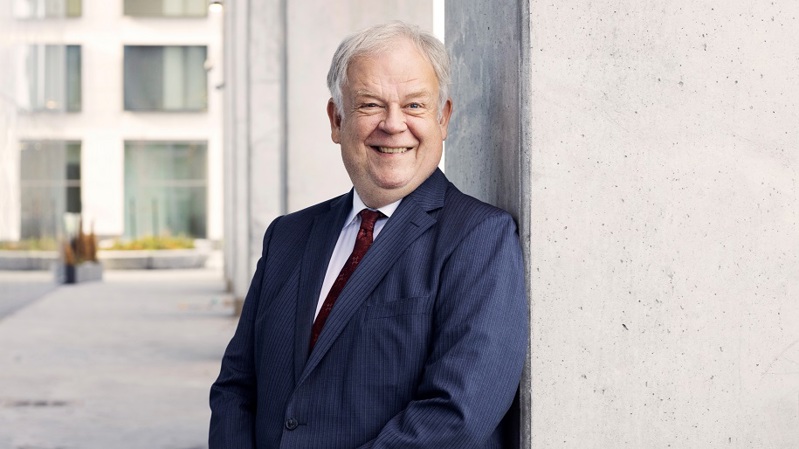A healthy working life is possible - but only if these three things are in place

Psychological safety and reducing regulation form the basis of a healthy workplace, says Susan Kallio, Human Resources Manager at Terveystalo.

Motivated employees work together to achieve a clear goal. There is a safe and supportive atmosphere at work. Managers can lead responsibly, the work is smooth and the job gives more than it takes.
But a number of structural challenges stand in the way of a healthy workplace.
The population is ageing and there is a skills shortage. People's ability to work is not managed holistically. Change is inevitable: new generations have a different approach to work, and their expectations and needs place entirely new demands on organisations.
In the light of the figures, many believe that a healthy working life is still a long way off. In early 2024, Terveystalo conducted a Healthy Working Life Barometer survey, to which nearly 1,000 business decision-makers responded. Less than half of them consider Finnish working life to be healthy. Respondents are particularly concerned about the fast pace of working life, the workload and the demands of efficiency.
A key question is whether well-being and performance management are reflected in organisational infrastructures and management platforms. There is still much unrealised potential in the use of data on employee well-being. In the midst of constant change, workplaces should remain attractive to employees and evolve to meet changing circumstances and employee needs.
Exhaustion, work stress and mental health challenges are still reflected, for example, in sickness absence and early invalidity pensions. According to a recent estimate by Kela, sickness absence due to mental health costs more than €1 billion per year in lost work effort in Finland.
What can people in decision-making positions in companies do in practice to make their organisations healthy workplaces?
The workplace foundation must at least be in place before any development work can be considered. Work structures, responsibilities and roles must be clear in order for work to run smoothly. Everyone in the organisation should have a shared understanding of the common goal and a willingness to contribute to it. People need to be listened to, managed and treated humanely.
According to the recipe for a healthy workplace, four main things need to be in place at the same time: a healthy job, a well-functioning work community, a well-being person and active leadership. Only then will the workplace be healthy for all.
Many companies are already showing signs of wanting to change working life in one way or another. Workplaces are providing opportunities for continuous learning and employees' wellbeing, resilience and resilience are being strengthened with the support of an occupational health partner.
Creating a healthy workplace
A healthy workplace is one where people are treated humanely, but are expected to take responsibility and deliver results.
Productivity is not just about efficiency, but also about taking action to improve people's ability to succeed at work, for example by improving tools and processes and using digital tools to streamline work. People's skills are harnessed, especially where they shine. Strengthening skills is a concrete way to tackle skills shortages, for example, and to further strengthen the skills already present in an organisation.
Other ways of tackling work-life threats include organisational flexibility, employee involvement in workplace development, and digital tools and the data they provide on workplace well-being.
Well-being data is an important tool for organisations to predict the future. It can also be used to build scenarios related to workplace risks, for example in cooperation with occupational health.
Much remains to be done to ensure that the workplaces of the future are healthy. As new generations enter the workforce, the diverse expectations of different generations in the world of work will become an increasingly important theme in workplace development. Future workers will increasingly be driven by the meaningfulness and inspiration of work.
The balance is increasingly shifting towards one in which the expectations of employer and employee are of equal value. People are constructing their working lives to suit themselves. In the future, employees will be sharing their skills for the benefit of more than one organisation at the same time. Therefore, employers in the workplace need to keep core competences attractive and provide enough opportunities to develop skills and engage employees, giving them the flexibility and ability to build pathways for employees at different ages and career stages. The balance is increasingly shifting in the direction of equal value for employer and employee expectations. Expectations must be met on both sides.

Susan Kallio is Human Resources Director at Terveystalo, who strongly believes that wisdom lives among people and is energised by communities, both at work and in leisure time, for example through children's activities.
Read more occupational health blogs

Occupational health psychologists are underutilized amidst the tsunami of mental health issues
The increase in psychological problems and burnout at work is constantly being discussed. Mental health disorders are one of the major causes of decreased work efficiency, absenteeism, and transition to disability pensions. One might ask why this situation persists, despite the fact that our country has a unique and highly regarded occupational health care system, with a large number of experts in the connection between work and mental health – us occupational health psychologists.

Where there is love for medicine, there is love for humanity
Hippocrates' wise words help us make the right choices. Our commitment to our mission, working for a healthier life, extends beyond the provision of quality health services to the promotion of human rights throughout our value chain.

Together towards a healthier workplace: The power of occupational health partnership
A healthy workplace is the result of collective effort, and Finnish business decision-makers share this view. Customer Relationship Director Terhi Nieminen explains how Terveystalo focuses on proactive measures and multidisciplinary collaboration, supporting the well-being of workplaces and employees comprehensively. This way, we create value that promotes sustainable success and addresses the challenges of the future working life.

How to create a meaningful working life?
Aino Kohtala, a leading psychologist and psychotherapist in one of the Terveystalo regions, points out that although many of the cornerstones of meaningful working life are changing independently of us, everyone has the opportunity to influence the functioning of their work community, the culture that supports their mood and their own and others' well-being.

Brave new world demands a new level of care: an international assessment model for quality and safety in remote appointments published
Terveystalo was the first in Finland to test a tool published by WHO in the spring that enables healthcare providers to assess the quality, safety and effectiveness of their remote appointments.

Here are the digital trends in healthcare 2024
Artificial intelligence, health assistants, preventive care and personalised medicine - the digital trends in healthcare in 2024 will focus on how we can modernise healthcare and tackle its deepest problems.